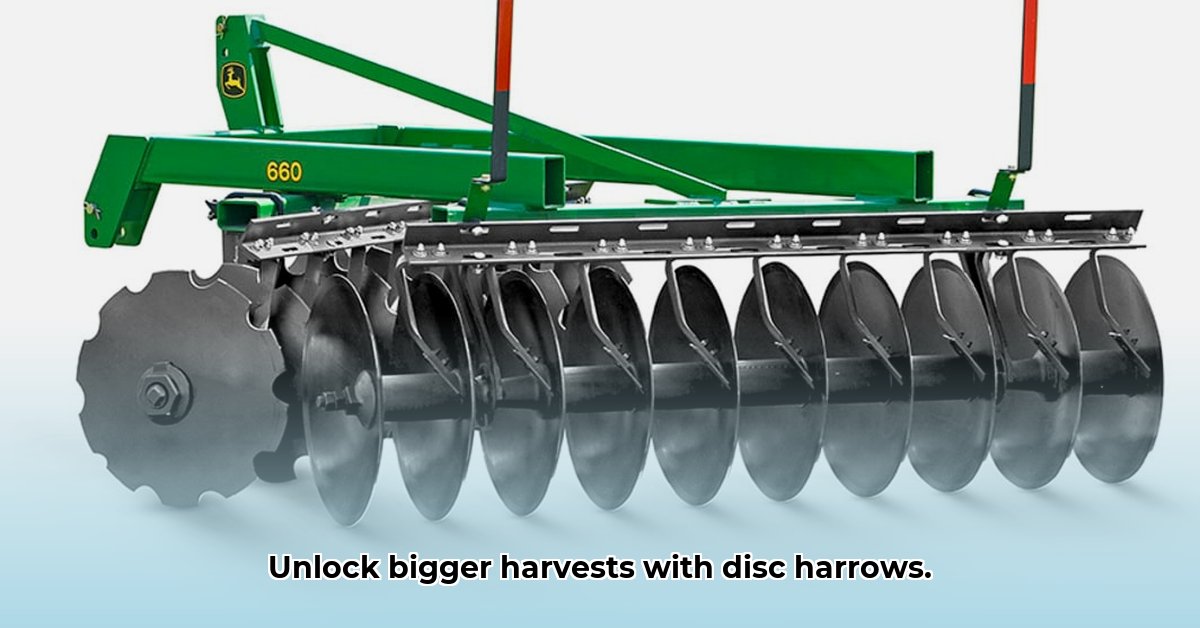
Understanding Tractor Disc Harrows for Sustainable Agriculture
Tractor disc harrows are essential implements for soil preparation in sustainable farming. They efficiently break up compacted soil, level the ground, and create a suitable seedbed, promoting healthy root development and maximizing crop yields. However, improper use can lead to soil erosion and compaction. This guide provides practical, step-by-step instructions for maximizing the benefits of disc harrowing while minimizing environmental impact. Understanding the various types and their applications is the first step. For more disc harrow information, see this helpful resource.
Types of Disc Harrows: Choosing the Right Tool
Several types of disc harrows exist, each suited to different soil conditions and farming needs. Choosing the correct one is vital for efficiency and soil health.
Tandem Disc Harrows
These heavy-duty harrows feature two rows of discs. They excel at leveling large areas and thoroughly mixing the soil, ideal for primary tillage (initial soil preparation). Their robust build makes them suitable for challenging soil types.
Single Disc Harrows
Simpler and more affordable, single disc harrows are better suited for smaller farms or for secondary tillage (seedbed preparation after initial soil preparation). They are appropriate when less aggressive soil manipulation is needed.
Heavy-Duty Disc Harrows
Designed for extremely compacted or challenging soil types, these harrows require powerful tractors. They are capable of deep tillage, but their use often necessitates the consideration of soil compaction risks.
Many manufacturers, including John Deere, offer a wide range of models within each category. Selecting the appropriate type depends on your specific needs and soil characteristics.
Choosing Your Disc Harrow: A Practical Decision Framework
Selecting the right disc harrow involves careful consideration of several factors, including:
- Soil Type: Heavy clay soils require harrows capable of breaking up dense clumps, while sandier soils may require less aggressive tools. A soil test will help determine the best approach.
- Acreage: Larger farms benefit from wider harrows to cover more ground efficiently. Smaller farms may find smaller models more suitable and economical.
- Tractor Horsepower: Ensure your tractor has sufficient power to pull the harrow without undue strain. Overtaxing the tractor decreases efficiency and can damage machinery.
- Budget: Disc harrows range in price significantly. Balancing cost with quality and durability is crucial for long-term efficiency.
Remember to always conduct a thorough risk assessment to avoid unintended negative consequences like soil erosion or compaction. The risk matrix (provided later) offers a structured framework for this crucial step. Does maximizing efficiency justify potentially higher risks in certain situations?
Operating and Maintaining Your Disc Harrow: A Step-by-Step Guide
Proper operation and maintenance are critical for maximizing the effectiveness and longevity of your disc harrow. This section outlines a step-by-step process.
- Pre-Operation Check: Before each use, inspect the harrow thoroughly. Check for damage, ensure proper lubrication, and sharpen or replace dull blades. This proactive approach prevents costly repairs and downtime.
- Depth Adjustment: Adjust the depth according to your soil type and tillage needs. Too shallow a pass might not adequately prepare the soil, while too deep a pass could lead to compaction.
- Speed Control: Maintain a consistent and appropriate speed. Too fast a speed can lead to uneven work and increased wear, while too slow a speed is inefficient use of time and resources.
- Angle Adjustment: Adjust the angle of the discs to optimize the cutting action. Experimentation, guided by soil type, will lead to the most efficient approach.
- Regular Maintenance: Regularly lubricate moving parts, clean the discs after each use, and address any repairs or damage promptly. Proactive maintenance helps prevent equipment failure and minimizes risks.
- Safety Precautions: Always wear appropriate safety gear, follow manufacturer's instructions, and ensure the area is clear of obstacles before operating.
Sustainable Tillage Practices: Minimizing Environmental Impact
Integrating your disc harrow into a sustainable farming strategy requires a focus on minimizing soil disturbance and conserving resources.
- Reduced Tillage: Minimize the number of passes to reduce soil disturbance. Over-tilling can degrade soil structure and reduce fertility.
- Cover Crops: Planting cover crops protects the soil, improving its structure and reducing erosion.
- No-Till Farming: With proper planning, a disc harrow might not always be necessary, especially with no-till farming techniques.
- Erosion Control: Employ contour farming or other erosion control techniques to protect topsoil.
Troubleshooting Common Disc Harrow Issues
This section addresses common problems and their solutions.
- Clogged Discs: Clean the discs regularly to prevent clogging and maintain efficiency.
- Uneven Tillage: Check disc angles, depth settings, and maintain consistent speed.
- Bent Discs: Repair or replace bent discs to avoid further damage and uneven tillage.
Risk Assessment Matrix
| Technology/Practice | Risk Category | Likelihood | Impact | Mitigation Strategy |
|---|---|---|---|---|
| Disc Harrow (Primary Tillage) | Soil Compaction | Medium | High | Minimize passes, optimize weight and speed, consider alternative tillage methods. |
| Disc Harrow (Secondary Tillage) | Soil Erosion | Low | Medium | Use cover crops, contour farming, or other erosion control techniques. |
| Improper Maintenance | Equipment Failure | High | High | Regular maintenance checks, lubrication, and prompt repairs are essential. |
| Incorrect Disc Setting | Reduced Efficiency | Medium | Medium | Proper training and soil testing are vital for optimal settings. |
| Unforeseen Weather Events (e.g., Rain) | Operational Disruption | Medium | Medium | Plan around weather forecasts and halt operations if conditions become too wet or difficult |
Conclusion: Sustainable Farming Through Informed Practices
Mastering disc harrow technology plays a significant role in achieving sustainable farming practices. By following this guide's steps and employing sustainable tillage methods, farmers can boost their harvests while minimizing the environmental footprint of their operation. The key is a combination of meticulous planning, proper equipment selection, and diligent maintenance.
Resources
- Farmers' Almanac: Sustainable Tillage Techniques (Example Resource – Replace with relevant links)